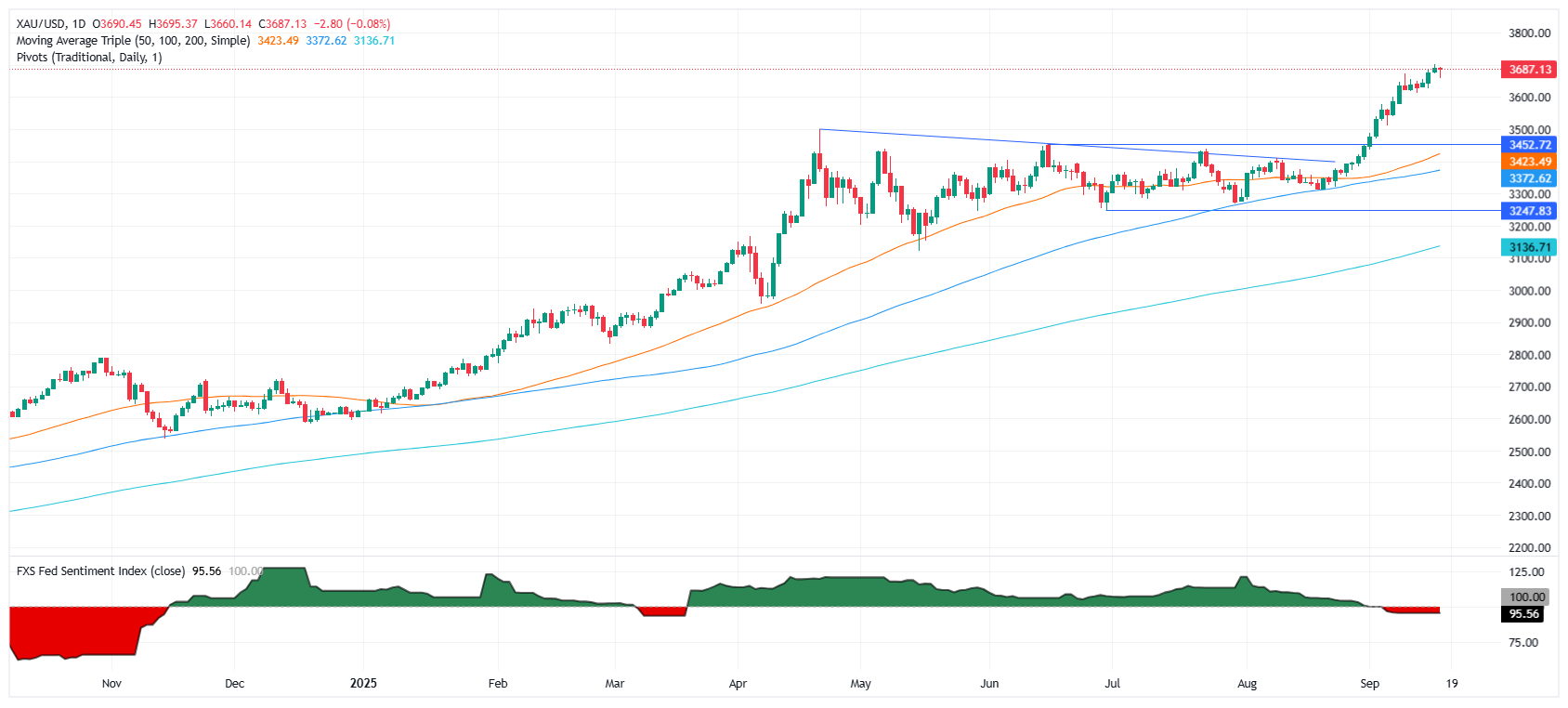Gold price steadies as Fed decision, Powell press conference loom
- XAU/USD trades below $3,700 as traders await Fed statement, SEP projections and Powell’s remarks.
- Fed is likely to cut 25 bps; dissent expected from both dovish Miran pushing for a 50 bps cut and hawkish Musalem, Schmid.
- Markets price 125 bps easing through 2026, with Powell expected to hedge on forward guidance to manage inflation risks.
Gold price holds firm during the session on Wednesday amid increasing tensions as market participants await the monetary policy decision of the Federal Reserve (Fed). XAU/USD trades at $3,685, down 0.09%.
Gold slips on profit-taking but holds firm ahead of expected 25 bps Fed cut and updated SEP outlook
Bullion’s trading session on Wednesday features profit taking as traders failed to keep Gold around $3,700 as the Fed is set to release its monetary policy statement.
The Fed is expected to reduce interest rates by 25 bps, not unanimously, as US President Donald Trump appointee Stephen Miran could push for a 50-bps cut. Other dissenters lie on the hawkish side, with St. Louis Fed President Alberto Musalem and Kansas City Fed President Jeffrey Schmid, who could vote to keep rates unchanged.
Once traders digest the statement, the Summary of Economic Projections (SEP) is up next, as it could dictate the path for the fed funds rate toward the end of the year and 2026. So far, traders have priced in close to 125 basis points of easing towards December of 2026, projecting rates to end at around the 3%-3.25% range.
Fed Chair Jerome Powell’s press conference at 18:30 GMT will be up next. Analysts of TD Securities wrote that Powell “is unlikely to commit to the future path of rate cuts.” This serves as a hedge for Powell, allowing flexibility if inflation rises unexpectedly.
Daily market movers: Gold steadies despite bad US housing data
- The US Dollar Index (DXY), which tracks the buck’s performance against a basket of six currencies, is up 0.05% at 96.70.
- US Treasury yields remain steady with the 10-year Treasury note, which is flat at around 4.03%. US real yields—calculated by subtracting inflation expectations from the nominal yield—hold firm at 1.66% at the time of writing.
- The US economic docket featured Housing Starts in August, which fell to its lowest level since May. Starts plunged by 8.5% MoM last month, after an increase of 3.4% in July and dropped from 1.429 million to 1.307 million. Building Permits also decreased by 3.7%.
- On Tuesday, the US Commerce Department announced that Retail Sales for August exceeded market expectations of 0.2%, rising by 0.6% MoM. Sales for the Control Group, used to calculate Gross Domestic Product (GDP) figures, expanded by 0.7% MoM, up from July’s print of 0.5%.
- After the US economic data release, the Atlanta Fed GDP Now dipped to 3.3% from 3.4% on Tuesday, after adding housing data to its calculations.
- Banks like the Deutsche Bank expect the Fed to cut interest rates by 25 bps in all three meetings this year, meaning that the Fed funds rate will reach the 3.50%-3.75% range.
Technical outlook: Gold price hovers near $3,690 as bulls target record high
Gold briefly surged to a new record of $3,703 on Tuesday before paring gains, consolidating at around the $3,680 area on Wednesday. The precious metal remains well-positioned to retest the all-time high, with scope to extend toward $3,750 and $3,800.
The Relative Strength Index (RSI) continues to flash overbought signals, hinting at limited near-term upside, yet the broader bias is bullish.
In the event of a 'buy the rumor, sell the fact' event on the Fed, which could push Gold prices lower, the first support would be $3,650. Once cleared, the next stop would be the September 11 low at $3,613, slightly above the $3,600 figure.

Gold FAQs
Gold has played a key role in human’s history as it has been widely used as a store of value and medium of exchange. Currently, apart from its shine and usage for jewelry, the precious metal is widely seen as a safe-haven asset, meaning that it is considered a good investment during turbulent times. Gold is also widely seen as a hedge against inflation and against depreciating currencies as it doesn’t rely on any specific issuer or government.
Central banks are the biggest Gold holders. In their aim to support their currencies in turbulent times, central banks tend to diversify their reserves and buy Gold to improve the perceived strength of the economy and the currency. High Gold reserves can be a source of trust for a country’s solvency. Central banks added 1,136 tonnes of Gold worth around $70 billion to their reserves in 2022, according to data from the World Gold Council. This is the highest yearly purchase since records began. Central banks from emerging economies such as China, India and Turkey are quickly increasing their Gold reserves.
Gold has an inverse correlation with the US Dollar and US Treasuries, which are both major reserve and safe-haven assets. When the Dollar depreciates, Gold tends to rise, enabling investors and central banks to diversify their assets in turbulent times. Gold is also inversely correlated with risk assets. A rally in the stock market tends to weaken Gold price, while sell-offs in riskier markets tend to favor the precious metal.
The price can move due to a wide range of factors. Geopolitical instability or fears of a deep recession can quickly make Gold price escalate due to its safe-haven status. As a yield-less asset, Gold tends to rise with lower interest rates, while higher cost of money usually weighs down on the yellow metal. Still, most moves depend on how the US Dollar (USD) behaves as the asset is priced in dollars (XAU/USD). A strong Dollar tends to keep the price of Gold controlled, whereas a weaker Dollar is likely to push Gold prices up.

